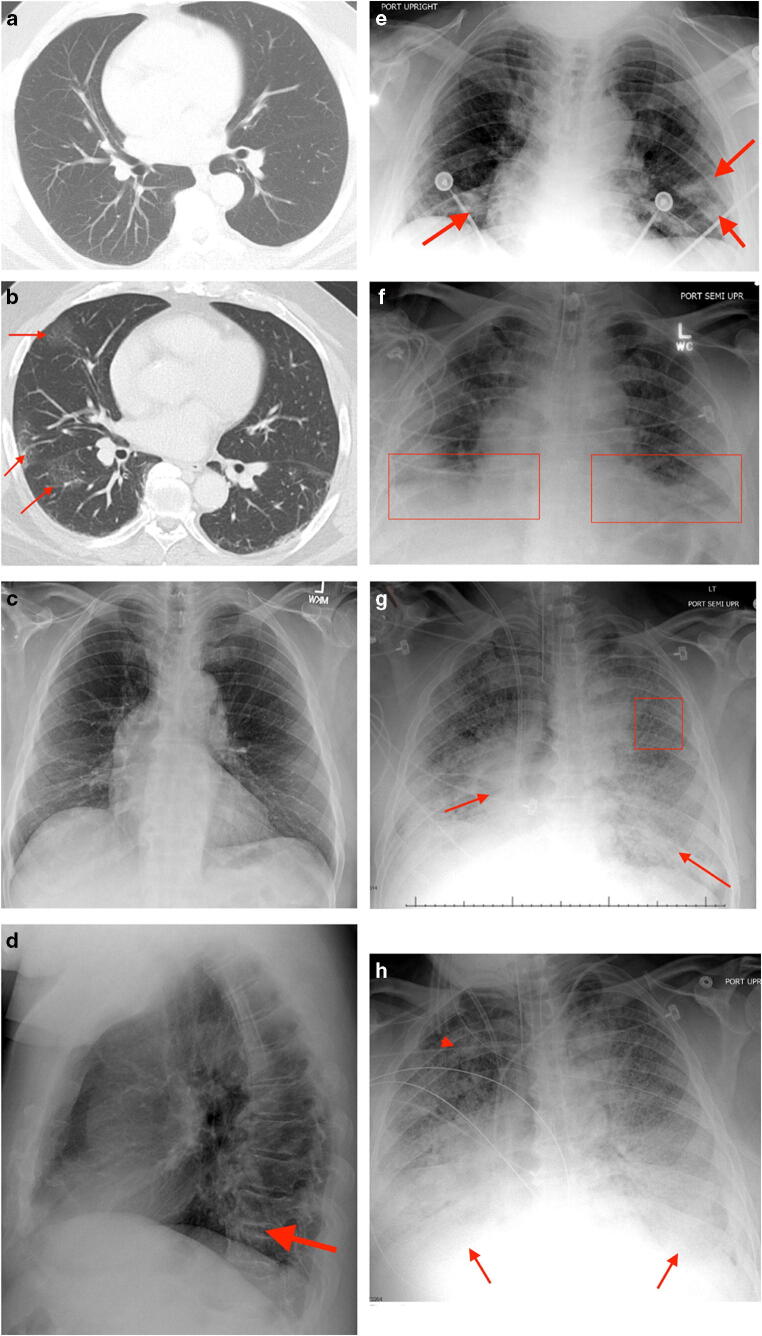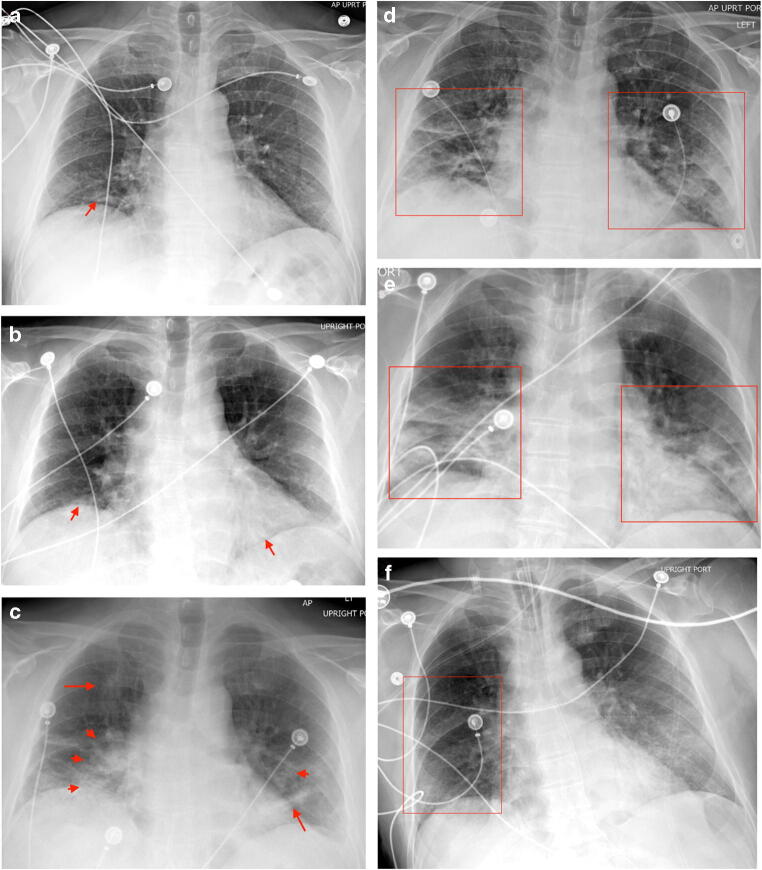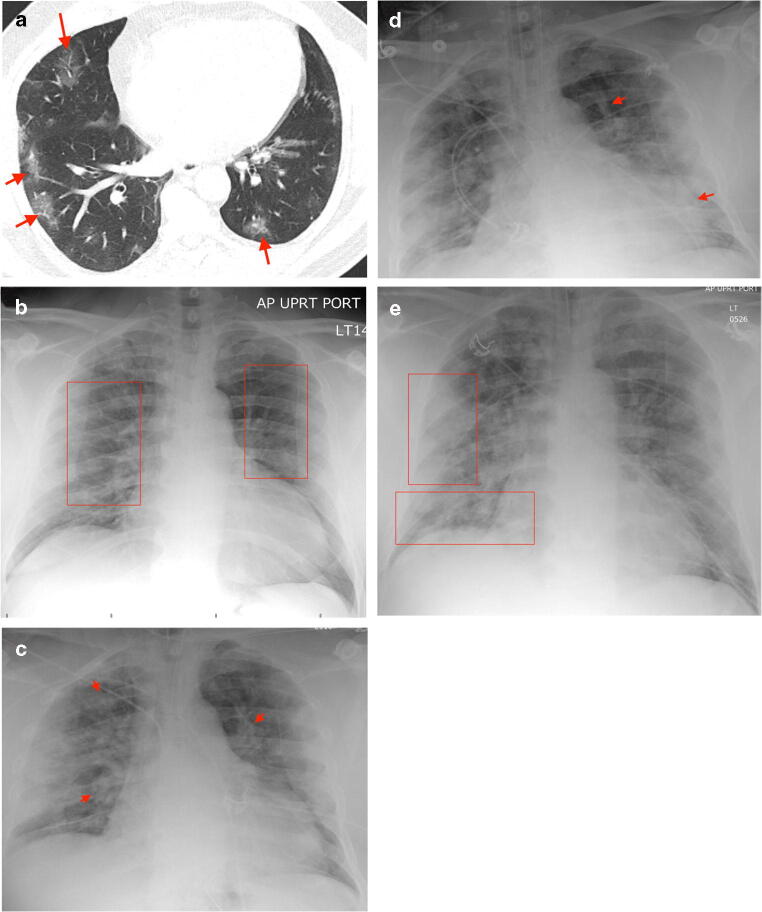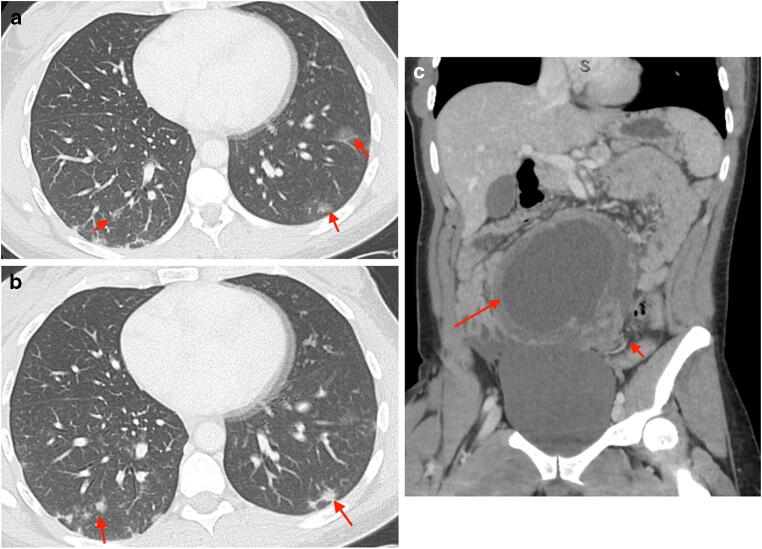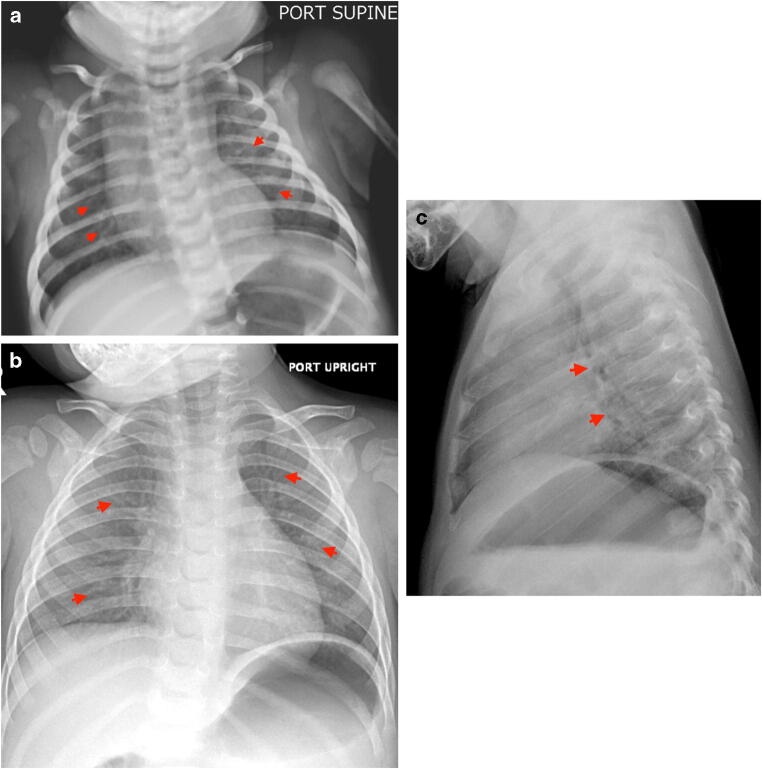Abstract
Purpose
The purpose of this study is to elucidate the chest imaging findings of suspected COVID-19 patients presenting to the emergency department and the relationship with their demographics and RT-PCR testing results.
Methods
Patients presenting to the ED between March 12 and March 28, 2020, with symptoms suspicious for COVID-19 and subsequent CXR and/or CT exam were selected. Patients imaged for other reasons with findings suspicious for COVID-19 were also included. Demographics, laboratory test results, and history were extracted from the medical record. Descriptive statistics were used to explore the relationship between imaging and these factors.
Results
A total of 227 patients from the emergency department were analyzed (224 CXRs and 25 CTs). Of the 192 patients with COVID-19 results, 173 (90.1%) had COVID-19 RT-PCR (+). Abnormal imaging (CXR, 85.7% and/or CT, 100%) was noted in 155 (89.6%) of COVID-19 RT-PCR (+) cases. The most common imaging findings were mixed airspace/interstitial opacities (39.8%) on CXR and peripheral GGOs on CT (92%). The most common demographic were African Americans (76.8%). Furthermore, 97.1% of African Americans were RT-PCR (+) compared to 65.8% of Caucasians.
Conclusion
We found a similar spectrum of thoracic imaging findings in COVID-19 patients as previous studies. The most common demographic were African Americans (76.8%). Furthermore, 97.1% of African Americans were RT-PCR (+) compared to 65.8% of Caucasians. Both CT and CXR can accurately identify COVID-19 pneumonitis in 89.6% of RT-PCR (+) cases, 89.5% of false negatives, and 72.7% of cases with no RT-PCR result.
Electronic supplementary material
The online version of this article (10.1007/s10140-020-01787-0) contains supplementary material, which is available to authorized users.
Keywords: COVID-19, Coronavirus, Emergency radiology, Ground glass opacities, Detroit
Introduction
Since the first reported outbreak of Severe Acute Respiratory Syndrome Coronavirus-2 (SARS-CoV-2), Coronavirus Disease 2019 (COVID-19), in Wuhan, Hubei Province, China in December 2019, a pandemic has ensued, inundating hospitals across the globe [1]. Clinical manifestations are varied, ranging from asymptomatic to death, complicating viral spread throughout the community [2, 3]. The virus has spread all across the U.S., with Michigan harboring the third-highest number of recorded cases in the country as of this writing. In particular, the Detroit Metropolitan area, where some of this study’s population base resides, has been demonstrating an alarming mortality rate. The currently accepted reference standard for testing COVID-19 is with real-time reverse transcriptase polymerase chain reaction (RT-PCR) of viral nucleic acid (further reference to a positive COVID-19 RT-PCR test will be denoted as RT-PCR(+)). However, given the reported limited sensitivity of this test on initial patient presentation (70%), some studies have suggested supplementation with chest computed tomography (CT) [4–7].
Chest CT also provides the additional benefit of stratifying disease severity [8, 9]. It is important to note that the typical CT findings of COVID-19 can manifest in asymptomatic patients early in disease progression or in patients with atypical symptoms that do not garner consideration of COVID-19 [4]. Although CT is more sensitive than a chest radiograph (CXR), given the time burden of CT scanner decontamination and downstream effect on image acquisition for other emergent exams, the American College of Radiology recommends use of portable CXR to mitigate the spread of communicable disease [10]. Furthermore, in Europe the utility of CXR as a triage tool for COVID-19 has been posited given the delay between specimen collection and RT-PCR result [11]. Early recognition of the disease, especially given reports of RT-PCR false negative (FN) rates up to 30% and asymptomatic COVID-19 infected individuals is paramount in reducing community spread and appropriately isolating hospitalized patients [12]. Therefore, familiarity with the imaging findings of COVID-19 allows the radiologist to make meaningful clinical suggestions and potentially limit the spread of disease.
The ED is currently serving as the front line for initial detection, evaluation, and management of COVID-19 patients. Hence, this study aims to further elucidate the initial CXR and CT appearance of patients with COVID-19 who present to the emergency department. Additionally, we present demographic information of our test-positive population that may elucidate the current alarming mortality rate and disease burden in Michigan.
Methods
There are no conflicts of interest to disclose. This study was reviewed by Beaumont Health’s Institutional Review Board (IRB) and found to be exempt and is HIPAA compliant. Informed consent was waived by the IRB.
This is a retrospective analysis of patients initially presenting to the emergency departments of three trauma centers in the Metropolitan Detroit area (a level I trauma center in Royal Oak, a level II trauma center in Troy, and a level III trauma center in Grosse Pointe) from March 12th, 2020 through March 28th, 2020 with symptoms suspicious for COVID-19 and subsequent imaging with a CXR or CT exam. Patients with either RT-PCR (+) or high clinical suspicion of COVID-19 infection were maintained in the study. RT-PCR COVID-19 testing was not treated as a primary outcome variable. Demographics of these patients including age (mean: 54 years, range: 6 weeks–95 years), sex (males: mean—53.5, range: 6 weeks–95 years; females: mean—54.9, range: 23–91 years), and race were obtained, as well as pertinent past medical history from the medical record.
Imaging exams were evaluated by (including, but not limited to): a neuroradiologist with 9 years of emergency radiology experience, an emergency radiologist with 15 years of experience, and a musculoskeletal radiologist with 13 years of experience. CT exams that included any portion of the lungs were evaluated including CT of the abdomen and pelvis, CT of the chest, pulmonary embolism (PE) protocol CT angiography (CTA), and CT of the chest, abdomen, and pelvis. All cases represented the initial imaging studies of patients who presented to the emergency department.
CXRs acquired were evaluated for the following findings: laterality (bilateral or unilateral), lung zone (superior, basal, perihilar, and multifocal), and density (airspace or interstitial—as defined in Chest Radiology: The Essentials by Collins et.al.) [13].
CT studies were assessed for findings associated with COVID-19 in previous studies including the following: peripheral ground glass opacities, consolidations, “crazy paving” pattern, and “reverse halo sign.” Other, less common findings, such as cavitation, pleural effusions, and/or lymphadenopathy were also noted if present.
Statistical analysis was based on the data collected on demographics, radiographic findings, CT findings, and laboratory studies. Additionally, counts, percentages, and means (age) were used for further statistical analysis.
Results
There were 174 of the total 227 patients imaged (76.6%) who were RT-PCR (+), 19/227 (8.3%) were RT-PCR (−) and 34/227 (15%) were not tested or pending. Patient age group distribution is presented in Table 1. Our patient population consisted of 120/227 males (53%) and 107/227 females (47%). Racial distribution is presented in Table 2, along with associated COVID-19 RT-PCR test results. African Americans represented the overwhelming majority of patients, in general (163/227, 71.8%), as well as those who were RT-PCR (+) (133/174, 76.8%). For comparison, 65.8% of Caucasians were RT-PCR (+).
Table 1.
Age group distribution within the patient population along with age group–specific COVID and imaging results (pending RT-PCR (n = 1) not included. No patients presented in age range 10–19 years)
| Age group (years) | Count (%) of total patients | RT-PCR (+) RT-PCR (−) Not tested |
Imaging (+) Imaging (−) |
Both RT-PCR (+) and imaging (+) |
|---|---|---|---|---|
| 0–9 | 2 (0.9%) |
2 0 0 |
2 0 |
2 |
| 20–29 | 12 (5.3%) |
5 2 5 |
9 3 |
5 |
| 30–39 | 25 (11.0%) |
19 1 5 |
21 4 |
17 |
| 40–49 | 47 (20.7%) |
35 1 11 |
41 6 |
30 |
| 50–59 | 55 (24.2%) |
44 3 7 |
50 5 |
42 |
| 60–69 | 52 (22.9%) |
42 6 3 |
48 4 |
38 |
| 70–79 | 23 (10.1%) |
18 3 2 |
18 5 |
15 |
| 80–89 | 8 (3.5%) |
7 1 0 |
6 2 |
5 |
| > 90 | 3 (1.3%) |
1 2 0 |
3 0 |
1 |
Table 2.
Distribution of race in the patient population
| Race | Total ED cases | Percent of total | RT-PCR(+) and imaging (+) | Percent of RT-PCR(+) and imaging (+) |
|---|---|---|---|---|
| African American | 163 | 71.8 | 119 | 76.8 |
| Asian | 4 | 1.8 | 3 | 1.9 |
| Caucasian | 50 | 22.0 | 23 | 14.8 |
| Other | 10 | 4.4 | 10 | 6.5 |
Information on the demographics of patients who presented to the ED at our three included hospital sites (Grosse Pointe, Troy, and Royal Oak) between February 1 and March 1, 2020 (before the surge of COVID-19 patients developed) was obtained. The distribution of the 22,124 patients was as follows: 30.0% (6,639) African American, 60.9% (13,484) Caucasian, 6.3% (1,400) other, and 2.3% (506) Asian.
The results of the imaging studies (CXR or CT) with associated COVID-19 RT-PCR results are provided in Table 3. Of the 173 RT-PCR (+) patients, 155 had abnormal imaging (89.6%), including 86% (171) of CXRs and 100% (16) of CTs. Demographic racial breakdown of test-positive and imaging-positive cases is as follows: African American (119, 76.8%), Caucasian (23, 14.8%), Asian (3, 1.9%), other (10, 6.5%), male (88, 56.8%), and female (67, 43.2%).
Table 3.
Imaging Results (+/−) by COVID-19 status
| COVID-19 RT-PCR result | Total imaging results (+/−) | CXR results (+/−) | CT results (+/−) |
|---|---|---|---|
| Positive (n = 173) | 155 (89.6%) | 148 (86.0%) | 16 (100%) |
| 18 (10.4%) | 24 (14%) | 0 (0%) | |
| Negative (n = 19) | 17 (89.5%) | 16 (88.9%) | 2(100%) |
| 2 (10.5%) | 2 (11.1%) | 0 (0%) | |
| No result (n = 33) | 24 (72.7%) | 21 (65.6%) | 5 (83.3%) |
| 9 (27.3%) | 11 (34.4%) | 1 (16.7%) |
The radiographic findings, including pattern, location, and laterality, are included in Table 4. Of the 227 patients who presented to the emergency department in this study, the vast majority underwent CXR (223, 98.2%). Out of a total of 186 abnormal CXRs the most common manifestation among abnormal findings was mixed airspace and interstitial opacities (74, 39.8%), multifocality (99, 53.2%), and bilaterality (165, 88.7%).
Table 4.
Chest X-ray findings (186 total abnormal CXRs)
| Pattern of opacification (%) | Location (%) | Laterality (%) |
|---|---|---|
| Interstitial and airspace—39.8% (74) | Multifocal—53.2% (99) | Bilateral—88.7% (165) |
| Interstitial—31.7% (59) | Basilar—40.3% (75) | Unilateral—11.3% (21) |
| Airspace—28.4% (53) | Perihilar—6.5% (12) | |
| Superior—1.1% |
CT protocols obtained on the included patients who presented to the ED and who underwent CT (25/227, 11.1%) consisted of 3 standard CT chest protocols, 9 pulmonary embolism (PE) protocol chest CT angiography studies (CTAs), 4 CT chest/abdomen/pelvis protocols, and 9 CT abdomen/pelvis protocols. Of the 25 patients who received a CT examination, 24 (96%) had findings suggestive of COVID-19 associated pneumonitis. Positive RT-PCR COVID-19 results were noted in 16 (64%) of these patients, and negative RT-PCR results were noted in 2 (8%) of these patients. Six (24%) of the patients who received a CT examination were not tested with RT-PCR, and one case remained in process at the end of the study.
Of the 25 CT examinations, 16 (64%) had both imaging findings suggestive of COVID-19 associated pneumonitis and positive RT-PCR test results for COVID-19 infection. Two (8%) of the patients with CT findings suggestive of COVID-19 associated pneumonitis had a negative RT-PCR test. Six (26%) of the patients who underwent CT did not receive RT-PCR testing, and five of these had CT findings suspicious for COVID-19 infection. One (4%) of the CT scans with suspicious findings for COVID-19 infection was still pending RT-PCR results at the time of study submission.
Although to varying degrees, 23/25 of the CT examinations (92%) demonstrated peripheral ground glass opacities. There were 12 CT examinations (48%) that demonstrated some degree of consolidation, most often patchy and peripheral. Reticular interstitial markings were noted in 3/25 examinations (12%), reverse halo or atoll sign in one exam (4%), and subpleural curvilinear opacities noted in one exam (4%).
The CT examinations in our study demonstrated classical imaging findings consistent with the CT findings of COVID-19 associated pneumonitis, as described by Zheng Ye et al., with GGO, consolidation, and reticular interstitial opacities being the most common findings, in decreasing order [8]. Furthermore, the previously reported timeline of disease progression, including ground glass opacities early in the disease with subsequent progression to the “crazy paving” pattern and ultimate progression into consolidation later in the disease, was further supported by our study (Fig. 1) [14, 15]. As previously reported with COVID-19 associated pneumonitis, pulmonary cavitations, pneumothorax, pulmonary nodules, pleural effusions, and lymphadenopathy were not demonstrated in our RT-PCR (+) patients who underwent CT [16]. Patients with FN RT-PCR testing displayed classical imaging for COVID-19 in our study, two of which are exhibited in Figs. 2 and 3. COVID-19 was suggested on numerous studies as a peripheral finding, one of which was a 33-year-old female with ovarian torsion as demonstrated in Fig. 4. Our study included the CXR findings of COVID-19 in the pediatric population as exhibited in Fig. 5.
Fig. 1.
Progression of disease on imaging in a 61-year-old male presenting with abdominal pain, fever, headache, and myalgias. CT chest w/o IV contrast 7 years prior to the current presentation demonstrates normal lung parenchyma (a). CT abdomen/pelvis w/ IV contrast on day 1 displays peripheral GGOs at the right lung base (arrows) (b). Frontal PA CXR on day 1 demonstrates interstitial opacities at the lung bases (c) and a subtle retrocardiac airspace opacity on the lateral CXR (arrow) (d). Portable AP frontal radiograph on day 3 demonstrates basal and peripheral airspace opacities (arrows) (e), becoming more confluent on day 6 (boxes) (f), with continued progression to diffuse interstitial opacities (box) and increasing airspace consolidation (arrows) on day 9, concerning for ARDS (g). Portable AP frontal radiograph on day 11 demonstrates interval increase in consolidation at the lung bases (arrows) and right upper lobe (arrowhead) (h). The patient expired on day 12. GGO: ground glass opacity, ARDS: acute respiratory distress syndrome
Fig. 2.
CXRs of a 57-year-old male with FN COVID-19 RT-PCR results. On day 1, the patient presented with cough and dyspnea for two days with a frontal AP radiograph demonstrating bilateral basal interstitial and airspace opacities (arrow) (a). The patient tested RT-PCR (−) on day 1 and was subsequently sent home on azithromycin. Frontal AP radiograph on day 2 after readmission for continued symptoms demonstrates increasing bibasilar airspace opacities (arrows), with the report suggesting a viral pneumonia pattern (b). Repeat RT-PCR on day 2 was again negative for COVID-19. Frontal AP radiograph on day 4 displays progression of right cardiophrenic airspace opacity (right-sided arrowheads), interval right upper lobe airspace opacity (right-sided arrow), and increasing left basal and mid lung airspace opacities (left-sided arrow and arrowhead) (c). The patient was empirically treated for viral pneumonitis and sent home on medications for a presumed asthma exacerbation. Frontal AP radiograph on day 6 after readmission with a fever displays increasing peripheral and basal airspace opacities (boxes) (d). The patient’s third repeat RT-PCR was negative for COVID-19. Frontal AP radiograph on day 8 after intubation displays increasing perihilar, basal, and peripheral airspace consolidation (boxes) with the report suggesting COVID-19 associated pneumonitis (e). On day 9, the fourth and final RT-PCR came back positive for COVID-19. Frontal AP radiograph on day 11 demonstrates improved aeration of the right hemithorax (box) (f). FN: false negative, RT-PCR: reverse transcriptase polymerase chain reaction, ICU: intensive care unit
Fig. 3.
Imaging of a 54-year-old male with a FN COVID-19 RT-PCR. On day 1, the patient presented with abdominal pain, subsequent negative RT-PCR, and an axial CT abdomen/pelvis w/ IV contrast image that displays bilateral peripheral GGOs (arrows) (a). Inflammatory changes around an appendiceal mucocele were also noted (not displayed). Frontal AP radiograph on day 1 demonstrates bilateral perihilar interstitial prominence (boxes) (b), with interval worsening by day 2 of the diffuse interstitial and peripheral airspace opacities (arrows) and a radiology report expressing high concern for COVID-19 (c). Repeat RT-PCR later that day was positive for COVID-19. Frontal AP radiograph on day 4 demonstrates mild interval progression of peripheral and basilar airspace consolidation bilaterally (arrows) (d), with continued progression of the peripheral (superior box) and basilar (inferior box) airspace opacities on day 6 (e). FN: false negative, RT-PCR: reverse transcriptase polymerase chain reaction
Fig 4.
Incidental COVID-19 findings in a 33-year-old female with abdominal pain, emesis, and fever. Axial CT abdomen/pelvis w/ IV contrast displays bilateral peripheral GGOs (arrows) (a) and more consolidated peripheral opacities (arrows) (b) as a peripheral finding. A diagnosis of COVID-19 was suggested on imaging with subsequent positive testing. The patient was taken to the operating room for abdominal findings under appropriate COVID-19 precautions. Coronal CT abdomen/pelvis w/ IV contrast displays ovarian torsion, with an enlarged ovary (long arrow) and twisting of adnexal vasculature (short arrow) (c). GGO: ground glass opacity
Fig 5.
Pediatric COVID-19 CXR findings. Frontal AP radiograph of a 6-week-old male with congenital adrenal insufficiency and RT-PCR COVID-19 (+) demonstrates streaky bilateral perihilar opacities (arrowheads) (a). In another pediatric patient, frontal AP radiograph of a 16-month-old male with congenitally absent kidney and RT-PCR COVID-19 (+) demonstrates prominent bilateral interstitial markings (arrows) in a pattern compatible with small-airway disease or viral pneumonitis (b) with peribronchial cuffing on the lateral CXR (arrows) (c). RT-PCR: reverse transcriptase polymerase chain reaction
Discussion
Supplementing RT-PCR limited sensitivity with imaging
Although CXR is not as sensitive as a chest CT in detecting COVID-19 associated pneumonitis, CXR has higher throughput and lower ionizing radiation exposure while still retaining the ability to demonstrate a pattern suggestive of viral pneumonitis. Specific CXR findings were described by Wong et al., with bilateral peripheral consolidations and/or GGOs as the most common manifestation [17]. This may strengthen suspicion for COVID-19 infection and ensure that appropriate precautions are taken to limit potential viral spread in patients who may not meet criteria for testing or who were RT-PCR (−). Three patients who initially tested RT-PCR (−) had imaging findings suggestive of COVID-19 associated pneumonitis. In these patients, a diagnosis of COVID-19 was suggested by the radiologist, and RT-PCR for COVID-19 was repeated, resulting in a repeat RT-PCR (+) in all scenarios (Fig. 6), with repeat testing performed up to 4 times in one patient. These cases elucidate the critical role a radiologist can play in supplementing the imperfect sensitivity of the RT-PCR test for COVID-19.
Fig 6.
Age distribution of total imaged patients compared with RT-PCR (+) (no patients presented from age range 10–19 years)
CT examinations
In the 5 exams (20%) for whom RT-PCR testing was not pursued, CT findings served a pertinent supplementary role in suggesting a diagnosis of COVID-19 associated pneumonitis, thereby enabling proper contact precautions inside the hospital and upon discharge. Furthermore, given that 9 of the CT examinations were focused on the abdomen/pelvis, a suggested diagnosis of COVID-19 was typically a peripheral and unexpected finding that had a profound impact on clinical management.
Peripheral findings
Given the variety of patients and imaging encountered in emergency radiology, it is necessary to be meticulous, especially during a pandemic, while evaluating images in order to identify peripheral findings that may suggest COVID-19 infection, especially in situations where COVID-19 infection is not suspected by the referring provider. These cases highlight the pertinence of detecting COVID-19 as a peripheral finding during this pandemic.
COVID-19 in the pediatric population
Two pediatric COVID-19 cases were identified in our patient group. A 6-week-old RT-PCR (+) male with a CXR demonstrating streaky bilateral perihilar opacities and a 16-month-old RT-PCR (+) male with a CXR displaying prominent bilateral interstitial markings in a pattern compatible with small-airway disease and/or viral pneumonitis. Both patients were discharged home in stable condition with the family on quarantine precautions. These CXR findings are compatible with previously published literature suggesting that the imaging manifestations of COVID-19 associated pneumonitis are milder in the pediatric population relative to the adult population [18]. This is a population not frequently associated with COVID-19, however should be entertained on imaging evaluation in the ED given the current pandemic.
Demographics
This study includes patients from three trauma centers in the Metropolitan Detroit area (Royal Oak, Troy, and Grosse Pointe) with an overall demographic distribution that does not necessarily reflect that of the surrounding general population. According to the 2019 U.S. Census Bureau data, these trauma centers are in communities with substantially lower percentages of African American residents (2.1% in Grosse Pointe City, 3.8% in Troy, and 3.7% Royal Oak) [19]. During February 2020, before the pandemic significantly affected Michigan, African Americans represented 30% of the 22,214 patient visits (versus 60.9% Caucasian) to the aforementioned EDs. It has been noted that 40% of Michigan’s deaths from COVID-19 at the time of this writing are African Americans however they only make up 12% of Michigan’s population [20]. Detroit (78.6% African American) has the highest number of test-positive cases in the state which may potentially be related to the association of healthcare disparities in underserved areas and the resultant disease burden [21]. While the demographics of the institutes’ surrounding communities vary, the exact cause and significance of the demographic distribution in this study are beyond the scope of this study and warrant further research.
Limitations and conclusion
Our study has a few limitations. First, it is limited to three hospitals in one geographic area. Second, the surge of COVID-19 infections during this time and the rate of positive imaging findings may be higher than in other areas. Third, given the hospital’s effort to minimize CT examinations, our subsequent smaller number of CT cases limits the scope of our imaging findings. Fourth, our results may not be as generalizable to an area without a large population of African Americans. Lastly, there is the inherent limitation of interobserver variability between the radiologists in the ED. Radiologists should be vigilant and meticulous in reviewing cases for findings suggestive of COVID-19; they may supplement the RT-PCR FN and can add value to patient care during this global pandemic.
Electronic supplementary material
(XLSX 166 kb)
Acknowledgments
We would like to thank the radiologists at Beaumont Health, especially those in the emergency division, for providing cases. We would like to thank all health care providers for contributing to patient care during this global pandemic.
Data availability
The data that support the findings of this study are included as supplementary material.
Compliance with ethical standards
IRB (#2020-096): Submission to the Beaumont Institutional Review Board found the study to be exempt.
Conflict of Interest
The authors declare that they have no conflict of interest.
Footnotes
Publisher’s note
Springer Nature remains neutral with regard to jurisdictional claims in published maps and institutional affiliations.
Contributor Information
Amir Pakray, Email: Amir.Pakray@beaumont.org.
David Walker, Email: David.Walker@beaumont.org.
Alexander Figacz, Email: Alexander.Figacz@beaumont.org.
Stephen Kilanowski, Email: stephen.kilanowski@beaumont.edu.
Casey Rhodes, Email: casey.rhodes@beaumont.edu.
Shashin Doshi, Email: shashin.doshi@beaumont.edu.
Mary Coffey, Email: Mary.Coffey@beaumont.org.
References
- 1.Hui DS, Azhar EI, Madani TA, Ntoumi F, Kock R, Dar O, Ippolito G et al (2020) The Continuing 2019-NCoV Epidemic Threat of Novel Coronaviruses to Global Health — The Latest 2019 Novel Coronavirus Outbreak in Wuhan, China. Int J Infect Dis 91:264–266. 10.1016/j.ijid.2020.01.009 [DOI] [PMC free article] [PubMed]
- 2.Zhou F, Yu T, Ronghui D, Fan G, Liu Y, Liu Z, Xiang J et al (2020) Clinical Course and Risk Factors for Mortality of Adult Inpatients with COVID-19 in Wuhan, China: A Retrospective Cohort Study. Lancet 395(10229):1054–1062. 10.1016/S0140-6736(20)30566-3 [DOI] [PMC free article] [PubMed]
- 3.Huang C, Wang Y, Li X, Ren L, Zhao J, Hu Y, Zhang L et al (2020) Clinical Features of Patients Infected with 2019 Novel Coronavirus in Wuhan, China. Lancet 395(10223):497–506. 10.1016/S0140-6736(20)30183-5 [DOI] [PMC free article] [PubMed]
- 4.Lin C, Ding Y, Xie B, Sun Z, Li X, Chen Z, Niu M (2020) Asymptomatic Novel Coronavirus Pneumonia Patient Outside Wuhan: The Value of CT Images in the Course of the Disease. Clin Imaging 63:7–9. 10.1016/j.clinimag.2020.02.008 [DOI] [PMC free article] [PubMed]
- 5.Fang Y, Zhang H, Xie J, Lin M, Ying L, Pang P, Ji W (2020) Sensitivity of Chest CT for COVID-19: Comparison to RT-PCR. Radiology 200432. 10.1148/radiol.2020200432 [DOI] [PMC free article] [PubMed]
- 6.Ai T, Yang Z, Hou H, Zhan C, Chen C, Lv W, Tao Q, Sun Z, Xia L (2020) Correlation of Chest CT and RT-PCR Testing in Coronavirus Disease 2019 (COVID-19) in China: A Report of 1014 Cases. Radiology 200642. 10.1148/radiol.2020200642 [DOI] [PMC free article] [PubMed]
- 7.Xie X, Zheng Z, Zhao W, Zheng C, Wang F, Liu J (2020) Chest CT for Typical 2019-NCoV Pneumonia: Relationship to Negative RT-PCR Testing. Radiology 200343. 10.1148/radiol.2020200343 [DOI] [PMC free article] [PubMed]
- 8.Ye Z, Zhang Y, Wang Y, Huang Z, Song B (2020.) Chest CT Manifestations of New Coronavirus Disease 2019 (COVID-19): A Pictorial Review. Eur Radiol. 10.1007/s00330-020-06801-0 [DOI] [PMC free article] [PubMed]
- 9.Liu K-C, Xu P, Lv W-F, Qiu X-H, Yao J-L, Jin-Feng G, Wei W (2020) CT Manifestations of Coronavirus Disease-2019: A Retrospective Analysis of 73 Cases by Disease Severity. Eur J Radiol 126. 10.1016/j.ejrad.2020.108941 [DOI] [PMC free article] [PubMed]
- 10.ACR Recommendations for the Use of Chest Radiography and Computed Tomography (CT) for Suspected COVID-19 Infection. https://www.acr.org/Advocacy-and-Economics/ACR-Position-Statements/Recommendations-for-Chest-Radiography-and-CT-for-Suspected-COVID19-Infection. Accessed 30 March 2020
- 11.The BMJ (2020) Lessons from the Frontline of the Covid-19 Outbreak. https://blogs.bmj.com/bmj/2020/03/20/lessons-from-the-frontline-of-the-covid-19-outbreak/
- 12.Yang Y, Yang M, Shen C, Wang F, Yuan J, Li J, Zhang M et al (2020) Evaluating the accuracy of different respiratory specimens in the laboratory diagnosis and monitoring the viral shedding of 2019-NCoV Infections. MedRxiv. 10.1101/2020.02.11.20021493
- 13.Collins J, Stern EJ (2015) Chest Radiology: The Essentials, Third edn. Wolters Kluwer Health
- 14.Bernheim A, Mei X, Huang M, Yang Y, Fayad ZA, Zhang N, Diao K et al (2020) Chest CT Findings in Coronavirus Disease-19 (COVID-19): Relationship to Duration of Infection. Radiology 200463. 10.1148/radiol.2020200463 [DOI] [PMC free article] [PubMed]
- 15.Pan Y, Guan H, Zhou S, Wang Y, Li Q, Zhu T, Hu Q, Xia L (2020.) Initial CT Findings and Temporal Changes in Patients with the Novel Coronavirus Pneumonia (2019-NCoV): A Study of 63 Patients in Wuhan, China. Eur Radiol. 10.1007/s00330-020-06731-x [DOI] [PMC free article] [PubMed]
- 16.Chung M, Bernheim A, Mei X, Zhang N, Huang M, Zeng X, Cui J et al (February 4, 2020) CT Imaging Features of 2019 Novel Coronavirus (2019-NCoV). Radiology 295(1):202–207. 10.1148/radiol.2020200230 [DOI] [PMC free article] [PubMed]
- 17.Wong HYF, Lam HYS, Fong AH-T, Leung ST, Chin TW-Y, Lo CSY, Lui MM-S et al (2020) Frequency and Distribution of Chest Radiographic Findings in COVID-19 Positive Patients. Radiology 201160. 10.1148/radiol.2020201160 [DOI] [PMC free article] [PubMed]
- 18.Liu M, Song Z, Xiao K High-Resolution Computed Tomography Manifestations of 5 Pediatric Patients With 2019 Novel Coronavirus. J Comput Assist Tomogr Publish Ahead of Print (March 25, 2020). 44:311–313. 10.1097/RCT.0000000000001023 [DOI] [PMC free article] [PubMed]
- 19.United States Census Bureau (2019) United States Census Data: Race and EthnicityCensus.gov
- 20.Michigan Department of Health and Human Services (2020) Coronavirus: Michigan DataMichigan.gov
- 21.Liu Z, Bing X, Zhi Z (2020) The epidemiological characteristics of an outbreak of 2019 Novel Coronavirus Diseases (COVID-19) in China. Chin J Epidemiol. 10.3760/cma.j.issn.0254-6450.2020.02.003
Associated Data
This section collects any data citations, data availability statements, or supplementary materials included in this article.
Supplementary Materials
(XLSX 166 kb)
Data Availability Statement
The data that support the findings of this study are included as supplementary material.



